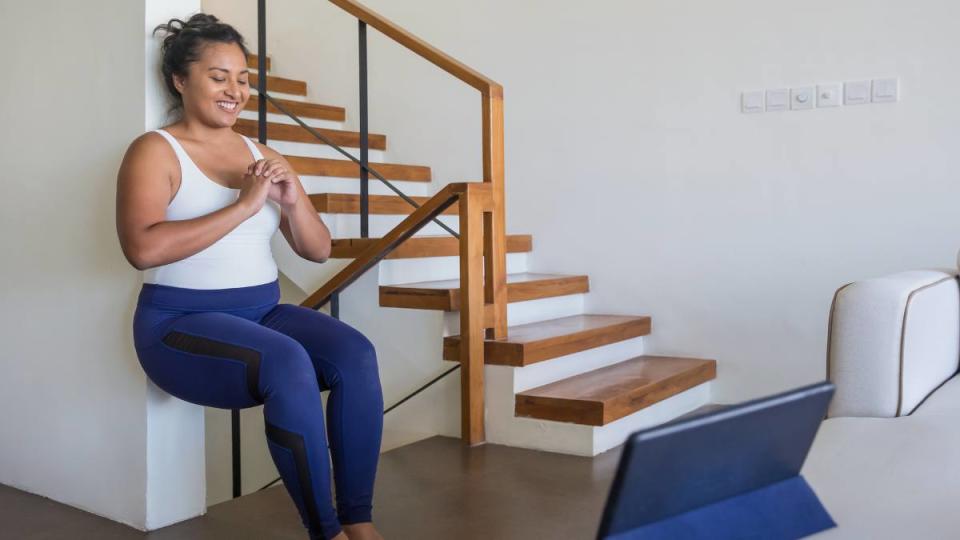Try This Squat Challenge + How the Results Can Boost Your Posture and Balance
Think about a movement pattern you do multiple times each day, then try to think of a basic exercise that would help you do it better. Did squats come to mind? “Squatting is such a basic everyday movement because we’re constantly sitting down and standing up or bending to pick things up from the floor,” says Jessica Smith, a fitness professional based in Sarasota, Florida, and creator of the online fitness platform JessicaSmith.Fitness. “As we get older, we tend to lose some of the mobility, strength and balance that allow us to do this very functional movement.” That's where a squat challenge can help — by assessing your current ability and helping you pinpoint ways to improve
People tend to think of a squat as a lower-body exercise, but Smith says “it’s really a total body exercise. You’re activating your quads and glutes, your back extensor muscles, your calves, inner thighs and hamstrings and your core to help with stability and balance.”
And because squats are weight-bearing exercises, they’re good for your bone density, too. In fact, doing squat training three times per week for 12 weeks has even been shown to improve bone density in the low back and hips in women with osteoporosis or osteopenia, according to a study in the Journal of Strength and Conditioning Research. What’s more, doing squats regularly can improve your posture and balance.
To assess your lower-body and core strength, try our squat challenge, following the instructions at right. “If you can perform more than 25 slow, controlled squats through a full range of motion in 90 seconds, that’s a good benchmark,” says Smith.
Related: Try This 30-Second Plank Test + See How the Results Can Help You Get Stronger
How to do a proper squat

Stand on the floor with your feet hip-width apart. Bend your knees, hinge at the hips, and push your butt back and down is if you were going to sit in a chair.
Bend your knees, hinge at the hips and push your butt back and down like you’re sitting in a chair. Keep your weight in your heels as you lower, knees in line with your toes — not in front of them. Keep your head and chest lifted and shoulders back as you lower yourself as far as you can safely go. If your thighs are parallel to the floor, that’s great!. You can reach your arms in front of you to help with balance.
3. When you reach your low point, press your heels into the floor, straighten your legs and return to standing position. Repeat as many times as you can in 90 seconds.
Related: Try This Quick Sit to Stand Fitness Test + See What the Results Say About Your Longevity
Were you able to do the squat challenge?
If you were able to do 25 or more, good for you! “Squatting is a very functional movement — you want to maintain strength and mobility, and squats are a great way to do that,” Smith says.
Did you struggle?

No worries! “Start where you can,” Smith says. If you can’t do an unsupported squat yet, try wall sits: Stand with your back pressed against a wall, feet hip-width apart. Walk your feet out two steps in front of you. With your back flat and your arms by your sides, then bend your knees to lower yourself until your thighs are parallel to the floor, knees directly over your ankles. Hold for at least 10 seconds; push back up to standing. Repeat 2 to 3 times, at least 3 times per week.
As your muscles get stronger, try the squat challenge again, starting with 30 seconds then build up from there, Smith says.
Related: 5 Classic Exercises for Full-Body Fitness
To increase the squat challenge . . .
Try doing squats while holding a 5-pound dumbbell in each hand, Smith says. You can also try a one-and-a-half leg stance. To do: Place your body weight primarily on your right foot as you squat with the toes of your left foot lightly placed on the floor to provide stability; do 10 squats in this position, then switch feet.
The bottom line
Even if you struggle to do them, it’s worth the effort to regularly include squats in your exercise routine. They’re key not only for their strength-building properties but for their additional benefits too.
“After age 35, you’re losing muscle mass every year, so you want to hold on to it and build it back as much as you can,” Smith explains. And squats are an excellent way to do that. Plus, she adds, “The more strength you build in your lower body, the more muscle support you’ll have, which eases pressure on your joints.”
For more to boost your fitness, keep reading!
Fascia Exercises Are the 10-Minute Routine Helping Women Get One Size Smaller — Fast!
Expert Advice: ‘I’m Exercising More, But I’m So Sore. What Can I Do to Stop the Pain?’
